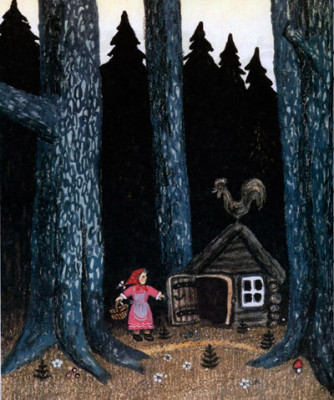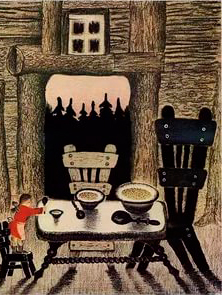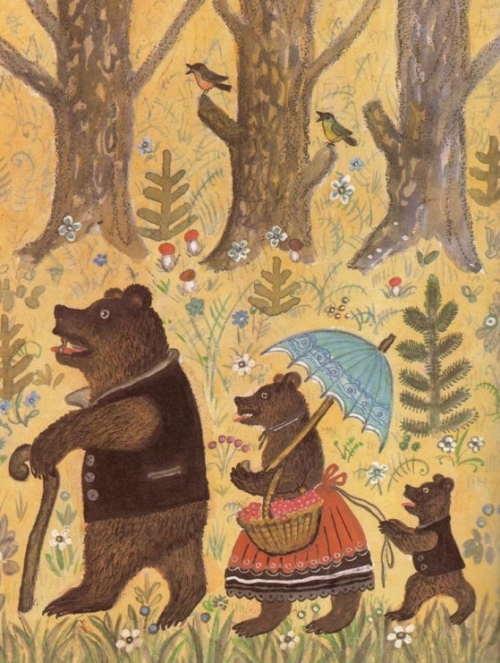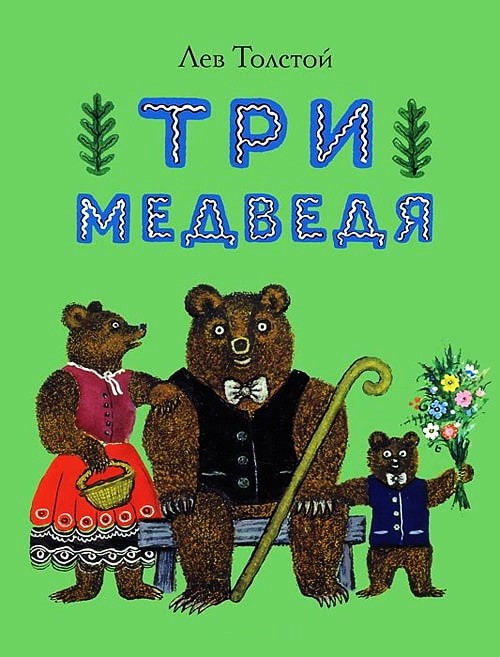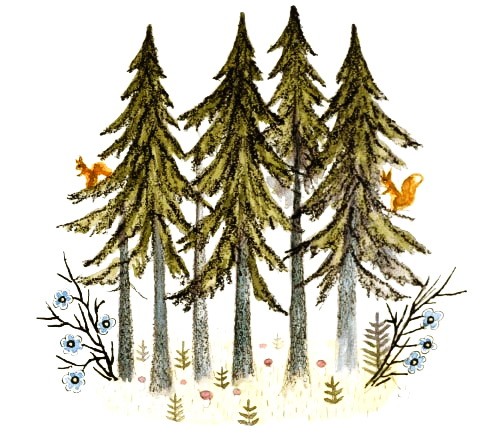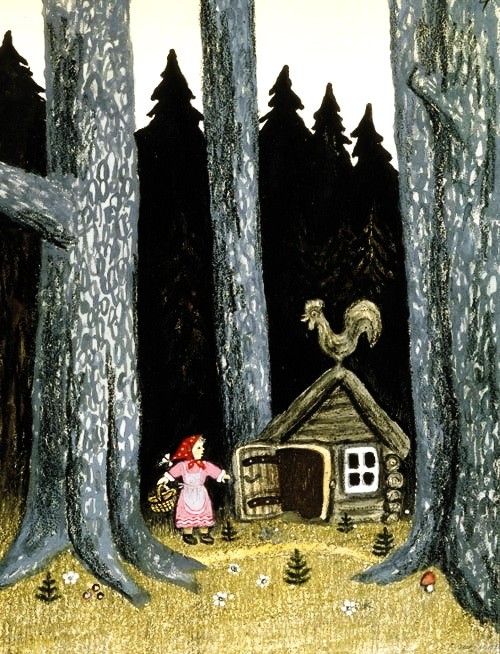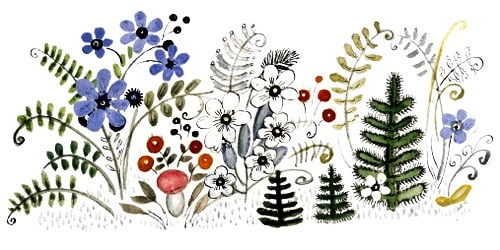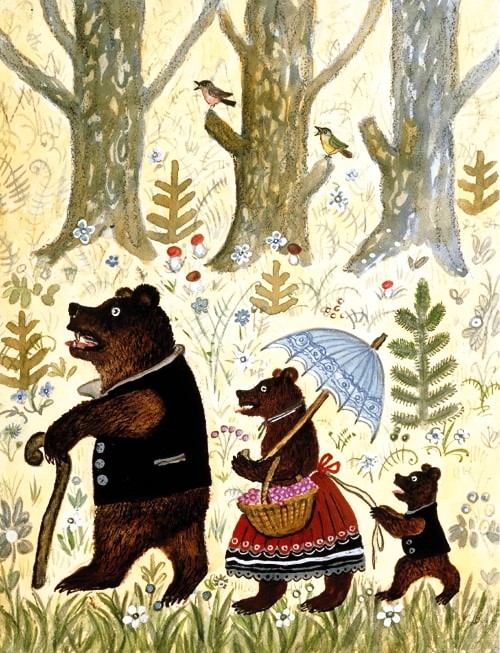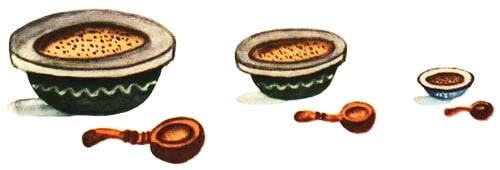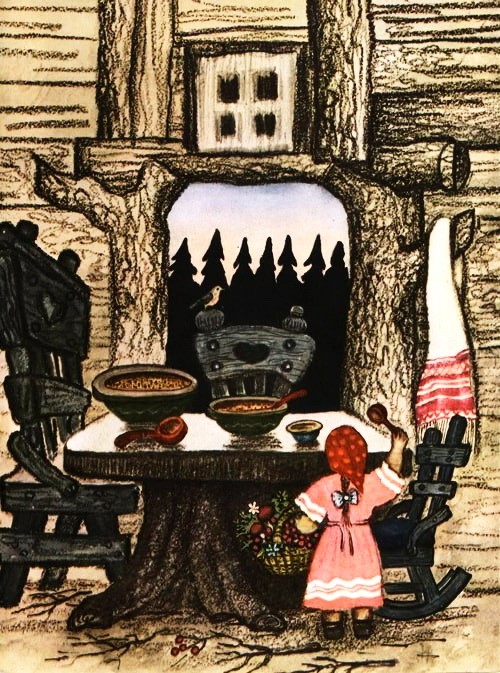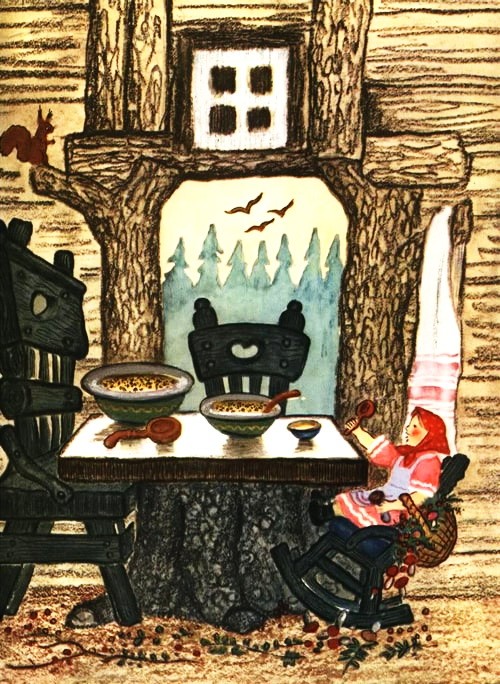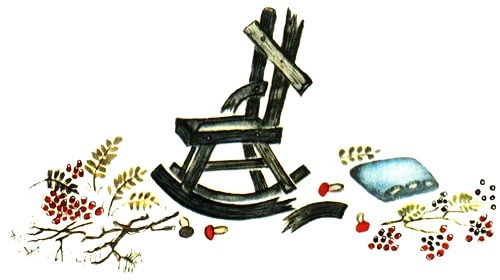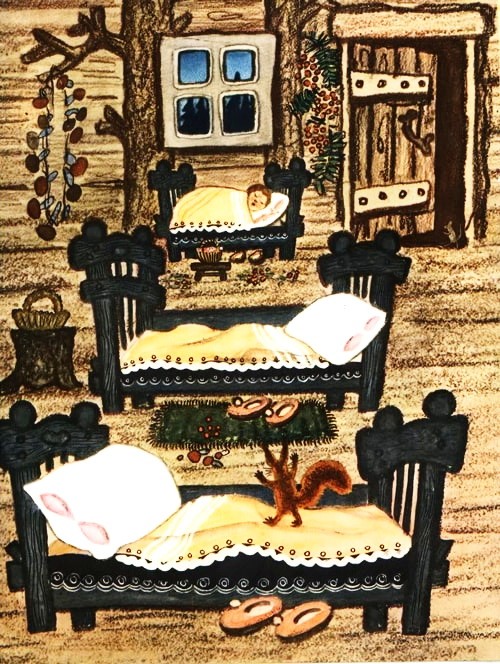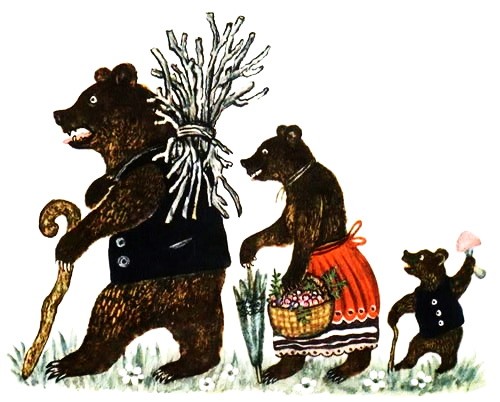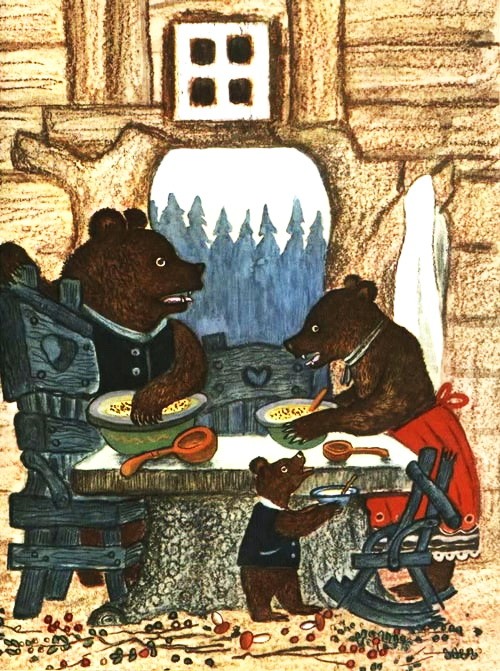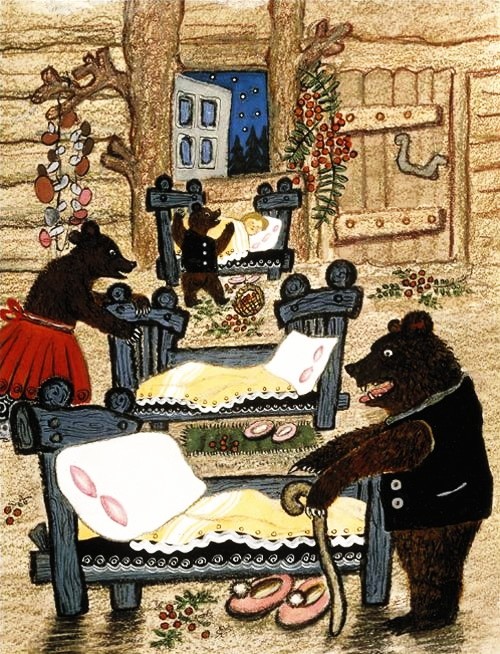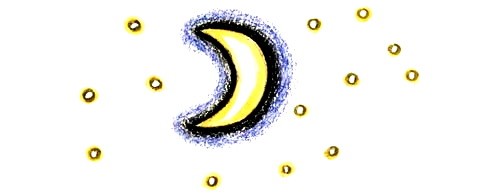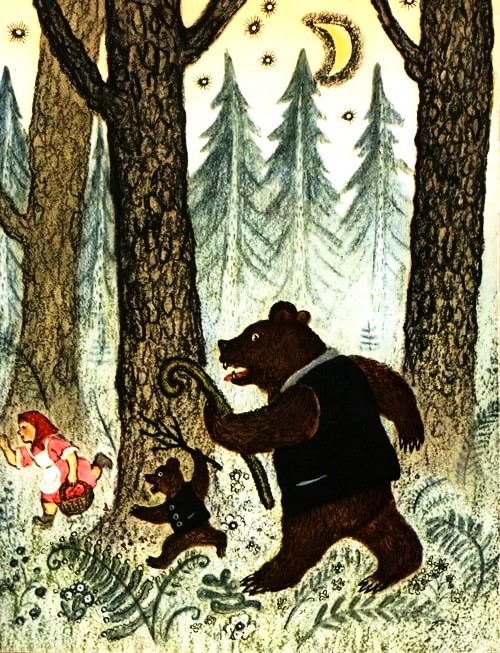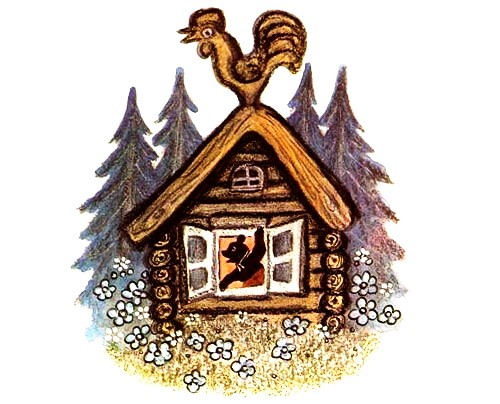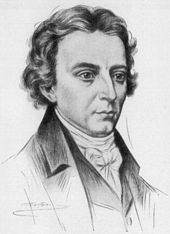Время чтения: 4 мин.
Одна девочка ушла из дома в лес. В лесу она заблудилась и стала искать дорогу домой, да не нашла, а пришла в лесу к домику.
Дверь была отворена; она посмотрела в дверь, видит: в домике никого нет, и вошла. В домике этом жили три медведя. Один медведь был отец, звали его Михайло Иванович. Он был большой и лохматый. Другой была медведица. Она была поменьше, и звали ее Настасья Петровна. Третий был маленький медвежонок, и звали его Мишутка. Медведей не было дома, они ушли гулять по лесу.
В домике было две комнаты: одна столовая, другая спальня. Девочка вошла в столовую и увидела на столе три чашки с похлебкой. Первая чашка, очень большая, была Михайлы Иваныча. Вторая чашка, поменьше, была Настасьи Петровнина; третья, синенькая чашечка, была Мишуткина. Подле каждой чашки лежала ложка: большая, средняя и маленькая.
Девочка взяла самую большую ложку и похлебала из самой большой чашки; потом взяла среднюю ложку и похлебала из средней чашки; потом взяла маленькую ложечку и похлебала из синенькой чашечки; и Мишуткина похлебка ей показалась лучше всех.
Девочка захотела сесть и видит у стола три стула: один большой — Михайлы Иваныча; другой поменьше — Настасьи Петровнин, а третий, маленький, с синенькой подушечкой — Мишуткин. Она полезла на большой стул и упала; потом села на средний стул, на нем было неловко; потом села на маленький стульчик и засмеялась — так было хорошо.
Она взяла синенькую чашечку на колени и стала есть. Поела всю похлебку и стала качаться на стуле.
Стульчик проломился, и она упала на пол.
Она встала, подняла стульчик и пошла в другую горницу. Там стояли три кровати: одна большая — Михайлы Иваныча; другая средняя — Настасьи Петровнина; третья маленькая — Мишенькина.
Девочка легла в большую, ей было слишком просторно; легла в среднюю — было слишком высоко; легла в маленькую — кроватка пришлась ей как раз впору, и она заснула.
А медведи пришли домой голодные и захотели обедать.
Большой медведь взял чашку, взглянул и заревел страшным голосом:
— КТО ХЛЕБАЛ В МОЕЙ ЧАШКЕ?
Настасья Петровна посмотрела на свою чашку и зарычала не так громко:
— КТО ХЛЕБАЛ В МОЕЙ ЧАШКЕ?
А Мишутка увидал свою пустую чашечку и запищал тонким голосом:
— КТО ХЛЕБАЛ В МОЕЙ ЧАШКЕ И ВСЕ ВЫХЛЕБАЛ?
Михаиле Иваныч взглянул на свой стул и зарычал страшным голосом:
— КТО СИДЕЛ НА МОЕМ СТУЛЕ И СДВИНУЛ ЕГО С МЕСТА?
Настасья Петровна взглянула на свой стул и зарычала не так громко:
— КТО СИДЕЛ НА МОЕМ СТУЛЕ И СДВИНУЛ ЕГО С МЕСТА?
Мишутка взглянул на свой сломанный стульчик и пропищал:
— КТО СИДЕЛ НА МОЕМ СТУЛЕ И СЛОМАЛ ЕГО?
Медведи пришли в другую горницу.
— КТО ЛОЖИЛСЯ В МОЮ ПОСТЕЛЬ И СМЯЛ ЕЕ? — заревел Михаиле Иваныч страшным голосом.
— КТО ЛОЖИЛСЯ В МОЮ ПОСТЕЛЬ И СМЯЛ ЕЕ? — зарычала Настасья Петровна не так громко.
А Мишенька подставил скамеечку, полез в свою кроватку и запищал тонким голосом:
— КТО ЛОЖИЛСЯ В МОЮ ПОСТЕЛЬ?
И вдруг он увидал девочку и завизжал так, как будто его режут:
— Вот она! Держи, держи! Вот она! Ай-я-яй! Держи!
Он хотел ее укусить.
Девочка открыла глаза, увидела медведей и бросилась к окну. Оно было открыто, она выскочила в окно и убежала. И медведи не догнали ее.
Сказки
Три медведя
Русская народная сказка
Одна девочка ушла из дома в лес. В лесу она заблудилась и стала искать дорогу домой, да не нашла, а пришла в лесу к домику.
Дверь была отворена; она посмотрела в дверь, видит: в домике никого нет, и вошла.
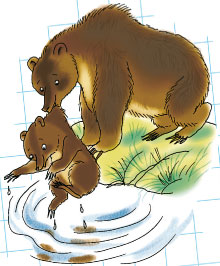
В домике этом жили три медведя. Один медведь был отец, звали его Михайло Иванович. Он был большой и лохматый. Другой была медведица. Она была поменьше, и её звали Настасья Петровна. Третий был маленький медвежонок, и звали его Мишутка. Медведей не было дома, они ушли гулять по лесу.
В домике было две комнаты. Девочка вошла в первую комнату и увидела на столе три чашки с похлебкой. Первая чашка, очень большая, была Михайлы Ивановича. Вторая чашка, поменьше, была Настасьи Петровны; третья, синенькая чашечка, была Мишуткина. Подле каждой чашки лежала ложка: большая, средняя и маленькая.
Девочка взяла самую большую ложку и похлебала из самой большой чашки; потом взяла среднюю ложку и похлебала из средней чашки; потом взяла маленькую ложечку и похлебала из синенькой чашечки; и Мишуткина похлебка ей показалась лучше всех.
Девочка захотела сесть и видит у стола три стула: один большой — Михайлы Ивановича; другой поменьше — Настасьи Петровны, а третий, маленький, с красненькой подушечкой — Мишуткин. Она полезла на большой стул и упала; потом села на средний стул, на нём было неловко; потом села на маленький стульчик и засмеялась — так было хорошо. Она взяла синенькую чашечку на колени и стала есть. Поела всю похлебку и стала качаться на стуле.
Стульчик проломился, и она упала на пол. Она встала, подняла стульчик и пошла в другую горницу. Там стояли три кровати: одна большая — Михаилы Иваныча; другая средняя — Настасьи Петровны; третья — Мишенькина. Девочка легла в большую, ей было слишком просторно; легла в среднюю — было слишком высоко; легла в маленькую — кроватка пришлась ей как раз впору, и она заснула.
А медведи пришли домой голодные и захотели обедать.
Большой медведь взял чашку, взглянул и заревел страшным голосом:
— Кто хлебал в моей чашки?
Настасья Петровна посмотрела свою чашку и зарычала не так громко:
— Кто хлебал в моей чашки?
А Мишутка увидал свою пустую чашку и запищал тонким голосом:
— Кто хлебал из моей чашки и всё выхлебал?
Михаило Иванович взглянул на свой стул и зарычал страшным голосом:
— Кто сидел на моём стуле и сдвинул его с места?
Настасья Петровна взглянула на свой стул и зарычала не так громко:
— Кто сидел на моём стуле и сдвинул его с места?
Мишутка взглянул на свой сломанный стульчик и пропищал:
— Кто сидел на моём стуле и сломал его?
Медведи пришли в другую горницу.
— Кто ложился на мою постель и смял её? — заревел Михаило Иваныч страшным голосом.
— Кто ложился на мою постель и смял её? — зарычала Настасья Петровна не так громко.
А Мишенька подставил скамеечку, полез в свою кроватку и запищал тонким голосом:
— Кто ложился на мою постель?
И вдруг он увидал девочку и завизжал так, как будто его режут:
— Вот она! Держи, держи! Вот она! Ай-я-яй! Держи!
Он хотел ее укусить.
Девочка открыла глаза, увидела медведей и бросилась к окну. Оно было открыто, девочка выскочила в окно и убежала. И медведи не догнали ее.
Русская сказка в обработке Льва Толстого
Три медведя — сказка о девочке, которая заблудилась в лесу и попала в домик медведей. Там она повела себя очень невоспитанно: без разрешения поела из каждой чашки, посидела на каждом стульчике, полежала в каждой кроватке, что очень разозлило вернувшихся домой медведей. Сказка представлена в изложении Л.Н. Толстого.
«Три медведя» читать
Одна девочка ушла из дома в лес. В лесу она заблудилась и стала искать дорогу домой, да не нашла, а пришла в лесу к домику.
Дверь была отворена: она посмотрела в дверь, видит, в домике никого нет, и вошла.
В домике этом жили три медведя. Один медведь был отец, звали его Михайло Иванович. Он был большой и лохматый. Другой была медведица. Она была поменьше, и звали ее Настасья Петровна. Третий был маленький медвежонок, и звали его Мишутка.
Медведей не было дома, они ушли гулять по лесу.
В домике было две комнаты: одна столовая, другая спальня. Девочка вошла в столовую и увидела на столе три чашки с похлебкой. Первая чашка, очень большая, была Михайлы Иваныча. Вторая чашка, поменьше, была Настасьи Петровны; третья, синенькая чашечка, была Мишуткина. Подле каждой чашки лежала ложка: большая, средняя и маленькая.
Девочка взяла самую большую ложку и похлебала из самой большой чашки; потом взяла среднюю ложку и похлебала из средней чашки; потом взяла маленькую ложечку и похлебала из синенькой чашечки; и Мишуткина похлебка ей показалась лучше всех.
Девочка захотела сесть и видит у стола три стула: один большой — Михайлы Иваныча; другой поменьше — Настасьи Петровны, а третий, маленький, с синенькой подушечкой — Мишуткин.
Она полезла на большой стул и упала; потом села на средний стул, на нем было неловко; потом села на маленький стульчик и засмеялась — так было хорошо. Она взяла синенькую чашечку на колени и стала есть. Поела всю похлебку и стала качаться на стуле.
Стульчик проломился, и она упала на пол. Она встала, подняла стульчик и пошла в другую горницу.
Там стояли три кровати: одна большая — Михаилы Иваныча; другая средняя — Настасьи Петровны; третья маленькая — Мишенькина.
Девочка легла в большую, ей было слишком просторно; легла в среднюю — было слишком высоко; легла в маленькую — кроватка пришлась ей как раз впору, и она заснула.
А медведи пришли домой голодные и захотели обедать.
Большой медведь взял чашку, взглянул и заревел страшным голосом:
— КТО ХЛЕБАЛ В МОЕЙ ЧАШКЕ?
Настасья Петровна посмотрела на свою чашку и зарычала не так громко:
— КТО ХЛЕБАЛ В МОЕЙ ЧАШКЕ?
А Мишутка увидал свою пустую чашечку и запищал тонким голосом:
— КТО ХЛЕБАЛ В МОЕЙ ЧАШКЕ И ВСЕ ВЫХЛЕБАЛ?
Михаиле Иваныч взглянул на свой стул и зарычал страшным голосом:
— КТО СИДЕЛ НА МОЕМ СТУЛЕ И СДВИНУЛ ЕГО С МЕСТА?
Настасья Петровна взглянула на свой стул и зарычала не так громко:
— КТО СИДЕЛ НА МОЕМ СТУЛЕ И СДВИНУЛ ЕГО С МЕСТА?
Мишутка взглянул на свой сломанный стульчик и пропищал:
— КТО СИДЕЛ НА МОЕМ СТУЛЕ И СЛОМАЛ ЕГО?
Медведи пришли в другую горницу.
— КТО ЛОЖИЛСЯ В МОЮ ПОСТЕЛЬ И СМЯЛ ЕЕ? — заревел Михаиле Иваныч страшным голосом.
— КТО ЛОЖИЛСЯ В МОЮ ПОСТЕЛЬ И СМЯЛ ЕЕ? — зарычала Настасья Петровна не так громко.
А Мишенька подставил скамеечку, полез в свою кроватку и запищал тонким голосом:
— КТО ЛОЖИЛСЯ В МОЮ ПОСТЕЛЬ?
И вдруг он увидал девочку и завизжал так, как будто его режут:
— Вот она! Держи, держи! Вот она! Ай-я-яй! Держи!
Он хотел ее укусить.
Девочка открыла глаза, увидела медведей и бросилась к окну. Оно было открыто, она выскочила в окно и убежала. И медведи не догнали ее.
Иллюстратор Ю.Васнецов
❤️ 1.4к
🔥 797
😁 828
😢 490
👎 441
🥱 560
Добавлено на полку
Удалено с полки
Достигнут лимит
| «Goldilocks and the Three Bears» | |
|---|---|
| by Robert Southey | |
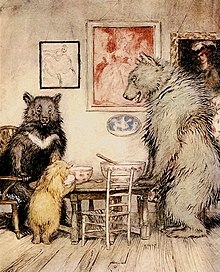
Illustration by Arthur Rackham, 1918, in English Fairy Tales by Flora Annie Steel |
|
| Country | United Kingdom |
| Genre(s) | Fairy tale |
| Published in | The Doctor |
| Publication type | Essay and story collection |
| Publisher | Longman, Rees, etc. |
| Media type | |
| Publication date | 1837 |
«Goldilocks and the Three Bears» (originally titled «The Story of the Three Bears«) is a 19th-century English fairy tale of which three versions exist. The original version of the tale tells of an obscene old woman who enters the forest home of three anthropomorphic bachelor bears while they are away. She eats some of their porridge, sits down on one of their chairs and breaks it, and sleeps in one of their beds. When the bears return and discover her, she wakes up, jumps out of the window, and is never seen again. The second version replaces the old woman with a young girl named Goldilocks, and the third and by far best-known version replaces the bachelor trio with a family of three.
What was originally a frightening oral tale became a cosy family story with only a hint of menace. The story has elicited various interpretations and has been adapted to film, opera, and other media. «Goldilocks and the Three Bears» is one of the most popular fairy tales in the English language.[1]
Original plot[edit]
Illustration in «The Story of the Three Bears» second edition, 1839, published by W. N. Wright of 60 Pall Mall, London
In Robert Southey’s version of the tale («The Story of the Three Bears»), three anthropomorphic bears – «a little, small, wee bear, a middle-sized bear, and a great, huge bear» – live together in a house in the woods. Southey describes them as very good-natured, trusting, harmless, tidy, and hospitable. Each of these «bachelor» bears has his own porridge bowl, chair, and bed. One day they make porridge for breakfast, but it is too hot to eat, so they decide to take a walk in the woods while their porridge cools. An old woman approaches the bears’ house. She has been sent out by her family because she is a disgrace to them. She is impudent, bad-mannered, foul-mouthed, ugly, dirty, and a vagrant deserving of a stint in the House of Correction. She looks through a window, peeps through the keyhole, and lifts the latch. Assured that no one is home, she walks in. The old woman eats the Wee Bear’s porridge, then settles into his chair and breaks it. Prowling about, she finds the bears’ beds and falls asleep in Wee Bear’s bed. The end of the tale is reached when the bears return. Wee Bear finds his empty bowl, his broken chair, and the old woman sleeping in his bed and cries, «Somebody has been lying in my bed, and here she is!» The old woman wakes, is chased out of the house by the huge bear and is never seen again.
Origins[edit]
The story was first recorded in narrative form by English writer and poet Robert Southey, and first published anonymously as «The Story of the Three Bears» in 1837 in a volume of his writings called The Doctor.[2][3] The same year Southey’s tale was published, the story was versified by editor George Nicol, who acknowledged the anonymous author of The Doctor as «the great, original concocter» of the tale.[4][5] Southey was delighted with Nicol’s effort to bring more exposure to the tale, concerned children might overlook it in The Doctor.[6] Nicol’s version was illustrated with engravings by B. Hart (after «C.J.»), and was reissued in 1848 with Southey identified as the story’s author.[7]
The story of the three bears was in circulation before the publication of Southey’s tale.[8] In 1813, for example, Southey was telling the story to friends, and in 1831 Eleanor Mure fashioned a handmade booklet about the three bears and the old woman for her nephew Horace Broke’s birthday.[4] Southey and Mure differ in details. Southey’s bears have porridge, but Mure’s have milk;[4] Southey’s old woman has no motive for entering the house, but Mure’s old woman is piqued when her courtesy visit is rebuffed;[9] Southey’s old woman runs away when discovered, but Mure’s old woman is impaled on the steeple of St Paul’s Cathedral.[10]
Folklorists Iona and Peter Opie point out in The Classic Fairy Tales (1999) that the tale has a «partial analogue» in «Snow White»: the lost princess enters the dwarfs’ house, tastes their food, and falls asleep in one of their beds. In a manner similar to the three bears, the dwarfs cry, «Someone’s been sitting in my chair!», «Someone’s been eating off my plate!», and «Someone’s been sleeping in my bed!» The Opies also point to similarities in a Norwegian tale about a princess who takes refuge in a cave inhabited by three Russian princes dressed in bearskins. She eats their food and hides under a bed.[11]
In 1865, Charles Dickens referenced a similar tale in Our Mutual Friend, but in that story the house belongs to hobgoblins rather than bears. Dickens’ reference however suggests a yet-to-be-discovered analogue or source.[12] Hunting rituals and ceremonies have been suggested and dismissed as possible origins.[13][14]
«Scrapefoot» illustration by John D. Batten in More English Fairy Tales (1895)
In 1894, «Scrapefoot», a tale with a fox as antagonist that bears striking similarities to Southey’s story, was uncovered by the folklorist Joseph Jacobs and may predate Southey’s version in the oral tradition. Some sources state that it was illustrator John D. Batten who in 1894 reported a variant of the tale at least 40 years old. In this version, the three bears live in a castle in the woods and are visited by a fox called Scrapefoot who drinks their milk, sits in their chairs, and rests in their beds.[4] This version belongs to the early Fox and Bear tale-cycle.[15] Southey possibly heard «Scrapefoot», and confused its «vixen» with a synonym for an unpleasant malicious old woman. Some maintain however that the story as well as the old woman originated with Southey.[3]
Southey most likely learned the tale as a child from his uncle William Tyler. Uncle Tyler may have told a version with a vixen (female fox) as the intruder, and then Southey may have later confused «vixen» with another common meaning of «a crafty old woman».[4] P. M. Zall writes in «The Gothic Voice of Father Bear» (1974) that «it was no trick for Southey, a consummate technician, to recreate the improvisational tone of an Uncle William through rhythmical reiteration, artful alliteration (‘they walked into the woods, while’), even bardic interpolation (‘She could not have been a good, honest Old Woman’)».[16] Ultimately, it is uncertain where Southey or his uncle learned the tale.
Later variations: Goldilocks[edit]
London based writer and publisher Joseph Cundall changed the antagonist from an old woman to a girl
Twelve years after the publication of Southey’s tale, Joseph Cundall transformed the antagonist from an ugly old woman to a pretty little girl in his Treasury of Pleasure Books for Young Children. He explained his reasons for doing so in a dedicatory letter to his children, dated November 1849, which was inserted at the beginning of the book:
The «Story of the Three Bears» is a very old Nursery Tale, but it was never so well told as by the great poet Southey, whose version I have (with permission) given you, only I have made the intruder a little girl instead of an old woman. This I did because I found that the tale is better known with Silver-Hair, and because there are so many other stories of old women.[11]
Once the little girl entered the tale, she remained – suggesting children prefer an attractive child in the story rather than an ugly old woman.[6] The juvenile antagonist saw a succession of names:[17] Silver Hair in the pantomime Harlequin and The Three Bears; or, Little Silver Hair and the Fairies by J. B. Buckstone (1853); Silver-Locks in Aunt Mavor’s Nursery Tales (1858); Silverhair in George MacDonald’s The Golden Key (1867); Golden Hair in Aunt Friendly’s Nursery Book (ca. 1868);[11] Silver-Hair and Goldenlocks at various times; Little Golden-Hair (1889);[15] and finally Goldilocks in Old Nursery Stories and Rhymes (1904).[11] Tatar credits English author Flora Annie Steel with naming the child in English Fairy Tales (1918).[3]
Goldilocks’s fate varies in the many retellings: in some versions, she runs into the forest, in some she is almost eaten by the bears but her mother rescues her, in some she vows to be a good child, and in some she returns home. Whatever her fate, Goldilocks fares better than Southey’s vagrant old woman who, in his opinion, deserved a stint in the House of Correction, and far better than Miss Mure’s old woman who is impaled upon a steeple in St Paul’s church-yard.[18]
Southey’s all-male ursine trio has not been left untouched over the years. The group was re-cast as Papa, Mama, and Baby Bear, but the date of this change is disputed. Tatar indicates it occurred by 1852,[18] while Katherine Briggs suggests the event occurred in 1878 with Mother Goose’s Fairy Tales published by Routledge.[15][17] With the publication of the tale by «Aunt Fanny» in 1852, the bears became a family in the illustrations to the tale but remained three bachelor bears in the text.
In Dickens’ version of 1858, the two larger bears are brother and sister, and friends to the little bear. This arrangement represents the evolution of the ursine trio from the traditional three male bears to a family of father, mother, and child.[19] In a publication c. 1860, the bears have become a family at last in both text and illustrations: «the old papa bear, the mama bear, and the little boy bear».[20] In a Routledge publication c. 1867, Papa Bear is called Rough Bruin, Mama Bear is Mammy Muff, and Baby Bear is called Tiny. Inexplicably, the illustrations depict the three as male bears.[21]
In publications subsequent to Aunt Fanny’s of 1852, Victorian nicety required editors to routinely and silently alter Southey’s «[T]here she sate till the bottom of the chair came out, and down came her’s, plump upon the ground» to read «and down she came», omitting any reference to the human bottom. The cumulative effect of the several changes to the tale since its original publication was to transform a fearsome oral tale into a cosy family story with an unrealised hint of menace.[17]
Interpretations[edit]
Maria Tatar, in The Annotated Classic Fairy Tales (2002), notes that Southey’s tale is sometimes viewed as a cautionary tale that imparts a lesson about the hazards of wandering off and exploring unknown territory. Like «The Tale of the Three Little Pigs», the story uses repetitive formulas to engage the child’s attention and to reinforce the point about safety and shelter.[18] Tatar points out that the tale is typically framed today as a discovery of what is «just right», but for earlier generations, it was a tale about an intruder who could not control herself when encountering the possessions of others.[22]
Illustration by John Batten, 1890
In The Uses of Enchantment (1976), the child psychologist Bruno Bettelheim describes Goldilocks as «poor, beautiful, and charming», and notes that the story does not describe her positively except for her hair.[23] Bettelheim mainly discussed the tale in terms of Goldilocks’ struggle to move past Oedipal issues to confront adolescent identity problems.[24]
In Bettelheim’s view, the tale fails to encourage children «to pursue the hard labour of solving, one at a time, the problems which growing up presents», and does not end as fairy tales should with the «promise of future happiness awaiting those who have mastered their Oedipal situation as a child». He believes the tale is an escapist one that thwarts the child reading it from gaining emotional maturity.
Tatar criticises Bettelheim’s views: «[His] reading is perhaps too invested in instrumentalizing fairy tales, that is, in turning them into vehicles that convey messages and set forth behavioural models for the child. While the story may not solve Oedipal issues or sibling rivalry as Bettelheim believes «Cinderella» does, it suggests the importance of respecting property and the consequences of just ‘trying out’ things that do not belong to you.»[18]
Elms suggests Bettelheim may have missed the anal aspect of the tale that would make it helpful to the child’s personality development.[23] In Handbook of Psychobiography Elms describes Southey’s tale not as one of Bettelheimian post-Oedipal ego development but as one of Freudian pre-Oedipal anality.[24] He believes the story appeals chiefly to preschoolers who are engaged in «cleanliness training, maintaining environmental and behavioural order, and distress about disruption of order». His own experience and his observation of others lead him to believe children align themselves with the tidy, organised ursine protagonists rather than the unruly, delinquent human antagonist. In Elms’s view, the anality of «The Story of the Three Bears» can be traced directly to Robert Southey’s fastidious, dirt-obsessed aunt who raised him and passed her obsession to him in a milder form.[24]
Literary elements[edit]
The story makes extensive use of the literary rule of three, featuring three chairs, three bowls of porridge, three beds, and the three title characters who live in the house. There are also three sequences of the bears discovering in turn that someone has been eating from their porridge, sitting in their chairs, and finally, lying in their beds, at which point is the climax of Goldilocks being discovered. This follows three earlier sequences of Goldilocks trying the bowls of porridge, chairs, and beds successively, each time finding the third «just right». Author Christopher Booker characterises this as the «dialectical three», where «the first is wrong in one way, the second in another or opposite way, and only the third, in the middle, is just right». Booker continues: «This idea that the way forward lies in finding an exact middle path between opposites is of extraordinary importance in storytelling».[25] This concept has spread across many other disciplines, particularly developmental psychology, biology, economics, and engineering where it is called the «Goldilocks principle».[26][27] In planetary astronomy, a planet orbiting its sun at just the right distance for liquid water to exist on its surface, neither too hot nor too cold, is referred to as being in the ‘Goldilocks Zone’. As Stephen Hawking put it, «like Goldilocks, the development of intelligent life requires that planetary temperatures be ‘just right‘«.[28]
Adaptations[edit]
Animated shorts[edit]
Looney Tunes’ Three Bears[edit]
Bugs Bunny and the Three Bears is a 1944 Merrie Melodies cartoon short directed by Chuck Jones.[29]: 148 The short was released on February 26, 1944, and features Bugs Bunny.[30] Later Looney Tunes and Merrie Melodies shorts continued the use of the same Three Bears family, distinguished by a short, irascible father named Henry, a deadpan mother, and a huge, oafish seven-year-old «baby,» still in diapers. Jones first brought back the Bears for his 1948 cartoon What’s Brewin’, Bruin?.[29]: 182 Here, Papa Bear decides that it’s time for the Bears to hibernate; however, various disturbances interfere. Junior’s voice is here supplied by Stan Freberg. Other Three Bears cartoons included Bear Feat (1948) and The Bee-Deviled Bruin (1949).
The final golden-age cartoon with this bear family, A Bear for Punishment (1951), parodies cultural values surrounding the celebration of Father’s Day. Looney Tunes comic books and more modern TV cartoons have now and then continued the use of the characters, occasionally in starring roles.
Terrytoons’ The Three Bears[edit]
A short film by Terrytoons titled The Three Bears was released in 1934 and remade in 1939. The remake famously adds stereotypical Italian accents and mannerisms to the bears; instead of eating porridge (as in the 1934 original), they eat spaghetti. The 1939 scene in which Papa Bear says «Somebody toucha my spaghet!» («somebody touched my spaghetti») became a viral Internet meme on YouTube in late 2017. While the 1939 bears are brown, not black, the commonly seen print is faded in such a way that they appear to have black fur, and so are often depicted in artwork based on the meme.
Others[edit]
- The MGM cartoons of the late 1930s included a Bear Family sub-series by Hugh Harman based on the story, starting with Goldilocks and the Three Bears (1939), then continuing on to A Rainy Day with the Bear Family (1940) and Papa Gets the Bird (1941). The MGM character of Barney Bear, originating concurrently, was at times advertised as being this Bear Family’s Papa, though creator Rudolf Ising appears to have always intended him as a separate character.
- Goldilocks and the Jivin’ Bears is a 1944 Merrie Melodies cartoon directed by Friz Freleng.[29]: 154 The cartoon depicts the Bears as an all-male trio of Black musicians, with Goldilocks as a teenage jitterbug.
- Now Hare This is a 1958 Looney Tunes cartoon directed by Robert McKimson whose second act of this short was based on «Goldilocks and Three Bears». The short was released on May 31, 1958, and stars Bugs Bunny.[29]: 308
- Goldimouse and the Three Cats is a 1960 Warner Bros. Looney Tunes animated cartoon directed by Friz Freleng.[29]: 323
- Goldilocks and the Three Bears/Rumpelstiltskin/Little Red Riding Hood/Sleeping Beauty (1984), a direct-to-video featurette produced by Lee Mendelson Film Productions.
- The Goldilocks and the 3 Bears Show (aka Goldilocks and the 3 Bears) is the third and final animated film in the Unstable Fables series. The film is a twisted retelling of the story of Goldilocks. The direct-to-DVD film was released on December 16, 2008.
Television animation[edit]
- Goldilocks is a half-hour musical animated film, the audio tracks for which were recorded in the summer of 1969, produced strictly for television in 1970 by DePatie-Freleng Enterprises (known for their work on The Pink Panther Show, of which the animation style is strongly reminiscent) and produced with the assistance of Mirisch-Geoffrey Productions.
- The three bears may or may not have been the inspiration for Stan and Jan Berenstain’s Berenstain Bears.
- In Rooster Teeth Productions RWBY, Yang Xiao Long is a carefree, reckless yellow-haired girl.[31] She is a «rule-breaker» who likes teddy bears. She is an allusion to Goldilocks which is reflected in her name, translated from Chinese as «sun», referring to the colour yellow.[32] Also, in her trailer, Yang confronts Hei «Junior» Xiong, whose name is Chinese for «black bear.» Combining this with his nickname, he alludes to the Baby Bear.
- The TV show Happily Ever After: Fairy Tales for Every Child featured an adaption of «Goldilocks and the Three Bears» in a Jamaican setting which featured the voices of Raven-Symoné as Goldilocks, Tone Loc as Desmond Bear, Alfre Woodard as Winsome Bear, and David Alan Grier as Dudley Bear.
- In the Simpsons episode «Bart’s New Friend,» the couch gag is based on Goldilocks and the Three Bears.
- In a Simpsons Halloween themed episode titled Treehouse of Horror XI, Bart and Lisa, who are fairy tale characters, enter the three bears house and follow the same route Goldilocks make in the original tale. But when they walk out of the house, they inadvertently lock the real Goldilocks inside the house who proceeds to get violently mauled to death by the bears.
- A fractured version of the story was made for Jay Ward’s Fractured Fairy Tales, in which Goldilocks had a winter resort and the three bears invade for hibernation purposes; Papa Bear was short and short-tempered, Mama Bear was more even-tempered, and Baby Bear was a huge, oversized dope who was «not sleepy».
- In the television show Hello Kitty’s Furry Tale Theater, the episode «Kittylocks and the Three Bears» is an adaptation of the story.
- A commercial for the 2005 Hummer portrayed the Three Bears returning from a family trip to their very upscale home to discover all the elements of the traditional story. They race to their garage to check on the status of the family Hummers. Mama Bear and Papa Bear are relieved that both vehicles are still in place, but Baby Bear is distraught to find his missing as the camera cuts away to Goldilocks (in this version portrayed by a very attractive young woman) rakishly smiling as she makes her getaway in Baby Bear’s Hummer down a scenic mountain road.
- Disney Junior’s Goldie & Bear premiered in 2016. The tale is set after the events of the story where Goldilocks (voiced by Natalie Lander) and Jack Bear (voiced by Georgie Kidder) eventually became best friends.
Live-action television[edit]
- «Goldilocks and the Three Bears» is the 9th episode of the television anthology Faerie Tale Theatre. It stars Tatum O’Neal as Goldilocks. Released in 1984
- In an episode of Sesame Street, a reversed version of the story titled «Baby Bear and the Three Goldilocks» was told (and written) by Telly and Elmo.
Video games[edit]
- The 1993 PC game Sesame Street: Numbers features a Sesame Street-esque twist on the story, and it is found in one of the three books in the game. Titled Count Goldilocks and the 3 Bears, it features the Count von Count taking the role of Goldilocks, as «Count Goldilocks». Instead of arriving after Papa, Mama, and Baby Bear go on their picnic, he arrives before they go out. He then proceeds to count them, their picnic baskets, wooden chairs, and beds. Each time he is done counting one of them, he asks why they have three of what he counted. At the end, Baby Bear says that they have three of everything because they are three bears. Then, they finally go on their picnic in the woods.
Music and audio[edit]
- Goldilocks is a musical with a book by Jean and Walter Kerr, music by Leroy Anderson, and lyrics by the Kerrs and Joan Ford.
- Songwriter Bobby Troup’s hipster interpretation titled «The Three Bears», first recorded by Page Cavanaugh in 1946, is often erroneously credited to «anonymous» and re-titled «Three Bears Rap», «Three Bears with a Beat», etc.
- Kurt Schwertsik’s 35-minute opera Roald Dahl’s Goldilocks premiered in 1997 at the Glasgow Royal Concert Hall. The opera’s setting is the Forest Assizes where Baby Bear stands accused of assaulting Miss Goldie Locks. The tables are turned when the defence limns the trauma suffered by the bears at the hands of that «brazen little crook», Goldilocks.[33]
- Goldilocks is a 12″ soundtrack vinyl album taken from the TV film Goldilocks shown on NBC on 31 March 1970. It was first released in 1970 as DL-3511 by Decca Custom Records for a special promotion of Evans-Black Carpets by Armstrong. When the promotion period had expired, the album was re-released by Disneyland Records as ST-3889 with an accompanying 12-page storybook. The recording is particularly important to the Bing Crosby career as he recorded commercial tracks in every year from 1926 to 1977 and this album represents his only recording work for 1969.[34]
- In 2014, MC Frontalot released a hip-hop rendition of the story as part of the album, Question Bedtime, in which the narrator warns the three bears of a ruthless woman called Gold Locks who hunts and eats bear cubs. An official music video was uploaded in 2015.[35]
- In 2016, professional wrestler Bray Wyatt read a dark version to Edge and Christian.[36]
Other references[edit]
- «Goldilocks Eats Grits» has the bears living in a cave in Georgia in the United States.[37]
See also[edit]
- Little Red Riding Hood
- Goldilocks principle
References[edit]
Citations[edit]
- ^ Elms 1977, p. 257
- ^ Southey, Robert (1837). «The Story of the Three Bears». The Doctor & C. Vol. 4. London, England: Longman, Rees, Orme, Brown, Green and Longman. pp. 318–326.
- ^ a b c Tatar 2002, p. 245
- ^ a b c d e Opie 1992, p. 199
- ^ Ober 1981, p. 47
- ^ a b Curry 1921, p. 65
- ^ Ober 1981, p. 48
- ^ Dorson 2001, p. 94
- ^ Ober 1981, pp. 2,10
- ^ Opie 1992, pp. 199–200
- ^ a b c d Opie 1992, p. 200
- ^ Ober 1981, p. xii
- ^ Ober 1981, p. x
- ^ Elms 1977, p. 259
- ^ a b c Briggs 2002, pp. 128–129
- ^ Quoted in: Ober 1981, p. ix
- ^ a b c Seal 2001, p. 91
- ^ a b c d Tatar 2002, p. 246
- ^ Ober 1981, p. 142
- ^ Ober 1981, p. 178
- ^ Ober 1981, p. 190
- ^ Tatar 2002, p. 251
- ^ a b Elms 1977, p. 264
- ^ a b c Schultz 2005, p. 93
- ^ Booker 2005, pp. 229–32
- ^ Martin, S J (August 2011). «Oncogene-induced autophagy and the Goldilocks principle». Autophagy. 7 (8): 922–3. doi:10.4161/auto.7.8.15821. PMID 21552010.
- ^ Boulding, K.E. (1981). Evolutionary Economics. Sage Publications. p. 200. ISBN 9780803916487.
- ^ S Hawking, The Grand Design (London 2011) p. 194
- ^ a b c d e Beck, Jerry; Friedwald, Will (1989). Looney Tunes and Merrie Melodies: A Complete Illustrated Guide to the Warner Bros. Cartoons. Henry Holt and Co. ISBN 0-8050-0894-2.
- ^ Lenburg, Jeff (1999). The Encyclopedia of Animated Cartoons. Checkmark Books. pp. 60-61. ISBN 0-8160-3831-7. Retrieved 6 June 2020.
- ^ Webb, Charles (1 June 2013). «EXCLUSIVE: Rooster Teeth’s ‘RWBY’ Yellow Trailer». MTV. Archived from the original on 9 June 2013. Retrieved 10 June 2013.
- ^ Rush, Amanda (12 July 2013). «FEATURE: Inside Rooster Teeth’s «RWBY»«. Crunchyroll. Retrieved 18 July 2013.
- ^ Roald Dahl’s Goldilocks
- ^ Reynolds, Fred. The Crosby Collection 1927-1977 (Part Five: 1961-1977 ed.). John Joyce. p. 127.
- ^ MC Frontalot (23 September 2014), MC Frontalot — Gold Locks (ft. Jean Grae) [OFFICIAL VIDEO], archived from the original on 21 December 2021, retrieved 11 March 2019
- ^ «Bray Wyatt tells a twisted fairy tale on the Edge & Christian Show, only on WWE Network». YouTube. 2 May 2016. Archived from the original on 21 December 2021.
Bray Wyatt puts a diabolical spin on ‘Goldilocks and the Three Bears’ on The Edge & Christian Show
- ^ Friedman, Amy; Johnson, Meredith (25 January 2015). «Goldilocks Eats Grits». Universal Uclick. Retrieved 25 January 2015.
General sources[edit]
- The Seven Basic Plots. Booker, Christopher (2005). «The Rule of Three». The Seven Basic Plots: Why We Tell Stories. Continuum International Publishing Group. ISBN 0-8264-5209-4.
- Briggs, Katherine Mary (2002) [1977]. British Folk Tales and Legends. Routledge. ISBN 0-415-28602-6.
- «Coronet: Goldilocks and the Three Bears». Internet Archive. Retrieved 21 February 2009.
- Curry, Charles Madison (1921). Children’s Literature. Rand McNally & Company. p. 179. ISBN 9781344646789.
three bears.
- «Disney: Goldilocks and the Three Bears». The Encyclopedia of Disney Animated Shorts. Archived from the original on 22 February 2013. Retrieved 21 February 2009.
- Dorson, Richard Mercer (2001) [1968]. The British Folklorists. Taylor & Francis. ISBN 0-415-20426-7.
- Elms, Alan C. (July–September 1977). ««The Three Bears»: Four Interpretations». The Journal of American Folklore. 90 (357): 257–273. doi:10.2307/539519. JSTOR 539519.
- «MGM: Goldilocks and the Three Bears». Retrieved 12 November 2010.
- Ober, Warren U. (1981). The Story of the Three Bears. Scholars Facsimiles & Reprints. ISBN 0-8201-1362-X.
- Opie, Iona; Opie, Peter (1992) [1974]. The Classic Fairy Tales. Oxford University Press. ISBN 0-19-211559-6.
- «Roald Dahl’s Goldilocks (1997)». Retrieved 3 January 2009.
- Schultz, William Todd (2005). Handbook of Psychobiography. Oxford University Press. ISBN 0-19-516827-5.
- Seal, Graham (2001). Encyclopedia of Folk Heroes. ABC-CLIO. ISBN 1-57607-216-9.
- Tatar, Maria (2002). The Annotated Classic Fairy Tales. W.W. Norton & Company. ISBN 0-393-05163-3.
External links[edit]
Wikisource has original text related to this article:
Wikisource has original text related to this article:
- «The Story of the Three Bears», manuscript by Eleanor Mure, 1831 — first recorded version
- «The Story of the Three Bears» by Robert Southey, 1837 – first published version
- «The Story of the Three Bears», versified by George Nicol, 2nd edition, 1839 (text)
- «The Three Bears» by Robert Southey – later version with «Silver-hair», a «little girl»
- «Goldilocks and the Three Bears», by Katharine Pyle, 1918 – later version with father, mother and baby bear
| «Goldilocks and the Three Bears» | |
|---|---|
| by Robert Southey | |

Illustration by Arthur Rackham, 1918, in English Fairy Tales by Flora Annie Steel |
|
| Country | United Kingdom |
| Genre(s) | Fairy tale |
| Published in | The Doctor |
| Publication type | Essay and story collection |
| Publisher | Longman, Rees, etc. |
| Media type | |
| Publication date | 1837 |
«Goldilocks and the Three Bears» (originally titled «The Story of the Three Bears«) is a 19th-century English fairy tale of which three versions exist. The original version of the tale tells of an obscene old woman who enters the forest home of three anthropomorphic bachelor bears while they are away. She eats some of their porridge, sits down on one of their chairs and breaks it, and sleeps in one of their beds. When the bears return and discover her, she wakes up, jumps out of the window, and is never seen again. The second version replaces the old woman with a young girl named Goldilocks, and the third and by far best-known version replaces the bachelor trio with a family of three.
What was originally a frightening oral tale became a cosy family story with only a hint of menace. The story has elicited various interpretations and has been adapted to film, opera, and other media. «Goldilocks and the Three Bears» is one of the most popular fairy tales in the English language.[1]
Original plot[edit]
Illustration in «The Story of the Three Bears» second edition, 1839, published by W. N. Wright of 60 Pall Mall, London
In Robert Southey’s version of the tale («The Story of the Three Bears»), three anthropomorphic bears – «a little, small, wee bear, a middle-sized bear, and a great, huge bear» – live together in a house in the woods. Southey describes them as very good-natured, trusting, harmless, tidy, and hospitable. Each of these «bachelor» bears has his own porridge bowl, chair, and bed. One day they make porridge for breakfast, but it is too hot to eat, so they decide to take a walk in the woods while their porridge cools. An old woman approaches the bears’ house. She has been sent out by her family because she is a disgrace to them. She is impudent, bad-mannered, foul-mouthed, ugly, dirty, and a vagrant deserving of a stint in the House of Correction. She looks through a window, peeps through the keyhole, and lifts the latch. Assured that no one is home, she walks in. The old woman eats the Wee Bear’s porridge, then settles into his chair and breaks it. Prowling about, she finds the bears’ beds and falls asleep in Wee Bear’s bed. The end of the tale is reached when the bears return. Wee Bear finds his empty bowl, his broken chair, and the old woman sleeping in his bed and cries, «Somebody has been lying in my bed, and here she is!» The old woman wakes, is chased out of the house by the huge bear and is never seen again.
Origins[edit]
The story was first recorded in narrative form by English writer and poet Robert Southey, and first published anonymously as «The Story of the Three Bears» in 1837 in a volume of his writings called The Doctor.[2][3] The same year Southey’s tale was published, the story was versified by editor George Nicol, who acknowledged the anonymous author of The Doctor as «the great, original concocter» of the tale.[4][5] Southey was delighted with Nicol’s effort to bring more exposure to the tale, concerned children might overlook it in The Doctor.[6] Nicol’s version was illustrated with engravings by B. Hart (after «C.J.»), and was reissued in 1848 with Southey identified as the story’s author.[7]
The story of the three bears was in circulation before the publication of Southey’s tale.[8] In 1813, for example, Southey was telling the story to friends, and in 1831 Eleanor Mure fashioned a handmade booklet about the three bears and the old woman for her nephew Horace Broke’s birthday.[4] Southey and Mure differ in details. Southey’s bears have porridge, but Mure’s have milk;[4] Southey’s old woman has no motive for entering the house, but Mure’s old woman is piqued when her courtesy visit is rebuffed;[9] Southey’s old woman runs away when discovered, but Mure’s old woman is impaled on the steeple of St Paul’s Cathedral.[10]
Folklorists Iona and Peter Opie point out in The Classic Fairy Tales (1999) that the tale has a «partial analogue» in «Snow White»: the lost princess enters the dwarfs’ house, tastes their food, and falls asleep in one of their beds. In a manner similar to the three bears, the dwarfs cry, «Someone’s been sitting in my chair!», «Someone’s been eating off my plate!», and «Someone’s been sleeping in my bed!» The Opies also point to similarities in a Norwegian tale about a princess who takes refuge in a cave inhabited by three Russian princes dressed in bearskins. She eats their food and hides under a bed.[11]
In 1865, Charles Dickens referenced a similar tale in Our Mutual Friend, but in that story the house belongs to hobgoblins rather than bears. Dickens’ reference however suggests a yet-to-be-discovered analogue or source.[12] Hunting rituals and ceremonies have been suggested and dismissed as possible origins.[13][14]
«Scrapefoot» illustration by John D. Batten in More English Fairy Tales (1895)
In 1894, «Scrapefoot», a tale with a fox as antagonist that bears striking similarities to Southey’s story, was uncovered by the folklorist Joseph Jacobs and may predate Southey’s version in the oral tradition. Some sources state that it was illustrator John D. Batten who in 1894 reported a variant of the tale at least 40 years old. In this version, the three bears live in a castle in the woods and are visited by a fox called Scrapefoot who drinks their milk, sits in their chairs, and rests in their beds.[4] This version belongs to the early Fox and Bear tale-cycle.[15] Southey possibly heard «Scrapefoot», and confused its «vixen» with a synonym for an unpleasant malicious old woman. Some maintain however that the story as well as the old woman originated with Southey.[3]
Southey most likely learned the tale as a child from his uncle William Tyler. Uncle Tyler may have told a version with a vixen (female fox) as the intruder, and then Southey may have later confused «vixen» with another common meaning of «a crafty old woman».[4] P. M. Zall writes in «The Gothic Voice of Father Bear» (1974) that «it was no trick for Southey, a consummate technician, to recreate the improvisational tone of an Uncle William through rhythmical reiteration, artful alliteration (‘they walked into the woods, while’), even bardic interpolation (‘She could not have been a good, honest Old Woman’)».[16] Ultimately, it is uncertain where Southey or his uncle learned the tale.
Later variations: Goldilocks[edit]
London based writer and publisher Joseph Cundall changed the antagonist from an old woman to a girl
Twelve years after the publication of Southey’s tale, Joseph Cundall transformed the antagonist from an ugly old woman to a pretty little girl in his Treasury of Pleasure Books for Young Children. He explained his reasons for doing so in a dedicatory letter to his children, dated November 1849, which was inserted at the beginning of the book:
The «Story of the Three Bears» is a very old Nursery Tale, but it was never so well told as by the great poet Southey, whose version I have (with permission) given you, only I have made the intruder a little girl instead of an old woman. This I did because I found that the tale is better known with Silver-Hair, and because there are so many other stories of old women.[11]
Once the little girl entered the tale, she remained – suggesting children prefer an attractive child in the story rather than an ugly old woman.[6] The juvenile antagonist saw a succession of names:[17] Silver Hair in the pantomime Harlequin and The Three Bears; or, Little Silver Hair and the Fairies by J. B. Buckstone (1853); Silver-Locks in Aunt Mavor’s Nursery Tales (1858); Silverhair in George MacDonald’s The Golden Key (1867); Golden Hair in Aunt Friendly’s Nursery Book (ca. 1868);[11] Silver-Hair and Goldenlocks at various times; Little Golden-Hair (1889);[15] and finally Goldilocks in Old Nursery Stories and Rhymes (1904).[11] Tatar credits English author Flora Annie Steel with naming the child in English Fairy Tales (1918).[3]
Goldilocks’s fate varies in the many retellings: in some versions, she runs into the forest, in some she is almost eaten by the bears but her mother rescues her, in some she vows to be a good child, and in some she returns home. Whatever her fate, Goldilocks fares better than Southey’s vagrant old woman who, in his opinion, deserved a stint in the House of Correction, and far better than Miss Mure’s old woman who is impaled upon a steeple in St Paul’s church-yard.[18]
Southey’s all-male ursine trio has not been left untouched over the years. The group was re-cast as Papa, Mama, and Baby Bear, but the date of this change is disputed. Tatar indicates it occurred by 1852,[18] while Katherine Briggs suggests the event occurred in 1878 with Mother Goose’s Fairy Tales published by Routledge.[15][17] With the publication of the tale by «Aunt Fanny» in 1852, the bears became a family in the illustrations to the tale but remained three bachelor bears in the text.
In Dickens’ version of 1858, the two larger bears are brother and sister, and friends to the little bear. This arrangement represents the evolution of the ursine trio from the traditional three male bears to a family of father, mother, and child.[19] In a publication c. 1860, the bears have become a family at last in both text and illustrations: «the old papa bear, the mama bear, and the little boy bear».[20] In a Routledge publication c. 1867, Papa Bear is called Rough Bruin, Mama Bear is Mammy Muff, and Baby Bear is called Tiny. Inexplicably, the illustrations depict the three as male bears.[21]
In publications subsequent to Aunt Fanny’s of 1852, Victorian nicety required editors to routinely and silently alter Southey’s «[T]here she sate till the bottom of the chair came out, and down came her’s, plump upon the ground» to read «and down she came», omitting any reference to the human bottom. The cumulative effect of the several changes to the tale since its original publication was to transform a fearsome oral tale into a cosy family story with an unrealised hint of menace.[17]
Interpretations[edit]
Maria Tatar, in The Annotated Classic Fairy Tales (2002), notes that Southey’s tale is sometimes viewed as a cautionary tale that imparts a lesson about the hazards of wandering off and exploring unknown territory. Like «The Tale of the Three Little Pigs», the story uses repetitive formulas to engage the child’s attention and to reinforce the point about safety and shelter.[18] Tatar points out that the tale is typically framed today as a discovery of what is «just right», but for earlier generations, it was a tale about an intruder who could not control herself when encountering the possessions of others.[22]
Illustration by John Batten, 1890
In The Uses of Enchantment (1976), the child psychologist Bruno Bettelheim describes Goldilocks as «poor, beautiful, and charming», and notes that the story does not describe her positively except for her hair.[23] Bettelheim mainly discussed the tale in terms of Goldilocks’ struggle to move past Oedipal issues to confront adolescent identity problems.[24]
In Bettelheim’s view, the tale fails to encourage children «to pursue the hard labour of solving, one at a time, the problems which growing up presents», and does not end as fairy tales should with the «promise of future happiness awaiting those who have mastered their Oedipal situation as a child». He believes the tale is an escapist one that thwarts the child reading it from gaining emotional maturity.
Tatar criticises Bettelheim’s views: «[His] reading is perhaps too invested in instrumentalizing fairy tales, that is, in turning them into vehicles that convey messages and set forth behavioural models for the child. While the story may not solve Oedipal issues or sibling rivalry as Bettelheim believes «Cinderella» does, it suggests the importance of respecting property and the consequences of just ‘trying out’ things that do not belong to you.»[18]
Elms suggests Bettelheim may have missed the anal aspect of the tale that would make it helpful to the child’s personality development.[23] In Handbook of Psychobiography Elms describes Southey’s tale not as one of Bettelheimian post-Oedipal ego development but as one of Freudian pre-Oedipal anality.[24] He believes the story appeals chiefly to preschoolers who are engaged in «cleanliness training, maintaining environmental and behavioural order, and distress about disruption of order». His own experience and his observation of others lead him to believe children align themselves with the tidy, organised ursine protagonists rather than the unruly, delinquent human antagonist. In Elms’s view, the anality of «The Story of the Three Bears» can be traced directly to Robert Southey’s fastidious, dirt-obsessed aunt who raised him and passed her obsession to him in a milder form.[24]
Literary elements[edit]
The story makes extensive use of the literary rule of three, featuring three chairs, three bowls of porridge, three beds, and the three title characters who live in the house. There are also three sequences of the bears discovering in turn that someone has been eating from their porridge, sitting in their chairs, and finally, lying in their beds, at which point is the climax of Goldilocks being discovered. This follows three earlier sequences of Goldilocks trying the bowls of porridge, chairs, and beds successively, each time finding the third «just right». Author Christopher Booker characterises this as the «dialectical three», where «the first is wrong in one way, the second in another or opposite way, and only the third, in the middle, is just right». Booker continues: «This idea that the way forward lies in finding an exact middle path between opposites is of extraordinary importance in storytelling».[25] This concept has spread across many other disciplines, particularly developmental psychology, biology, economics, and engineering where it is called the «Goldilocks principle».[26][27] In planetary astronomy, a planet orbiting its sun at just the right distance for liquid water to exist on its surface, neither too hot nor too cold, is referred to as being in the ‘Goldilocks Zone’. As Stephen Hawking put it, «like Goldilocks, the development of intelligent life requires that planetary temperatures be ‘just right‘«.[28]
Adaptations[edit]
Animated shorts[edit]
Looney Tunes’ Three Bears[edit]
Bugs Bunny and the Three Bears is a 1944 Merrie Melodies cartoon short directed by Chuck Jones.[29]: 148 The short was released on February 26, 1944, and features Bugs Bunny.[30] Later Looney Tunes and Merrie Melodies shorts continued the use of the same Three Bears family, distinguished by a short, irascible father named Henry, a deadpan mother, and a huge, oafish seven-year-old «baby,» still in diapers. Jones first brought back the Bears for his 1948 cartoon What’s Brewin’, Bruin?.[29]: 182 Here, Papa Bear decides that it’s time for the Bears to hibernate; however, various disturbances interfere. Junior’s voice is here supplied by Stan Freberg. Other Three Bears cartoons included Bear Feat (1948) and The Bee-Deviled Bruin (1949).
The final golden-age cartoon with this bear family, A Bear for Punishment (1951), parodies cultural values surrounding the celebration of Father’s Day. Looney Tunes comic books and more modern TV cartoons have now and then continued the use of the characters, occasionally in starring roles.
Terrytoons’ The Three Bears[edit]
A short film by Terrytoons titled The Three Bears was released in 1934 and remade in 1939. The remake famously adds stereotypical Italian accents and mannerisms to the bears; instead of eating porridge (as in the 1934 original), they eat spaghetti. The 1939 scene in which Papa Bear says «Somebody toucha my spaghet!» («somebody touched my spaghetti») became a viral Internet meme on YouTube in late 2017. While the 1939 bears are brown, not black, the commonly seen print is faded in such a way that they appear to have black fur, and so are often depicted in artwork based on the meme.
Others[edit]
- The MGM cartoons of the late 1930s included a Bear Family sub-series by Hugh Harman based on the story, starting with Goldilocks and the Three Bears (1939), then continuing on to A Rainy Day with the Bear Family (1940) and Papa Gets the Bird (1941). The MGM character of Barney Bear, originating concurrently, was at times advertised as being this Bear Family’s Papa, though creator Rudolf Ising appears to have always intended him as a separate character.
- Goldilocks and the Jivin’ Bears is a 1944 Merrie Melodies cartoon directed by Friz Freleng.[29]: 154 The cartoon depicts the Bears as an all-male trio of Black musicians, with Goldilocks as a teenage jitterbug.
- Now Hare This is a 1958 Looney Tunes cartoon directed by Robert McKimson whose second act of this short was based on «Goldilocks and Three Bears». The short was released on May 31, 1958, and stars Bugs Bunny.[29]: 308
- Goldimouse and the Three Cats is a 1960 Warner Bros. Looney Tunes animated cartoon directed by Friz Freleng.[29]: 323
- Goldilocks and the Three Bears/Rumpelstiltskin/Little Red Riding Hood/Sleeping Beauty (1984), a direct-to-video featurette produced by Lee Mendelson Film Productions.
- The Goldilocks and the 3 Bears Show (aka Goldilocks and the 3 Bears) is the third and final animated film in the Unstable Fables series. The film is a twisted retelling of the story of Goldilocks. The direct-to-DVD film was released on December 16, 2008.
Television animation[edit]
- Goldilocks is a half-hour musical animated film, the audio tracks for which were recorded in the summer of 1969, produced strictly for television in 1970 by DePatie-Freleng Enterprises (known for their work on The Pink Panther Show, of which the animation style is strongly reminiscent) and produced with the assistance of Mirisch-Geoffrey Productions.
- The three bears may or may not have been the inspiration for Stan and Jan Berenstain’s Berenstain Bears.
- In Rooster Teeth Productions RWBY, Yang Xiao Long is a carefree, reckless yellow-haired girl.[31] She is a «rule-breaker» who likes teddy bears. She is an allusion to Goldilocks which is reflected in her name, translated from Chinese as «sun», referring to the colour yellow.[32] Also, in her trailer, Yang confronts Hei «Junior» Xiong, whose name is Chinese for «black bear.» Combining this with his nickname, he alludes to the Baby Bear.
- The TV show Happily Ever After: Fairy Tales for Every Child featured an adaption of «Goldilocks and the Three Bears» in a Jamaican setting which featured the voices of Raven-Symoné as Goldilocks, Tone Loc as Desmond Bear, Alfre Woodard as Winsome Bear, and David Alan Grier as Dudley Bear.
- In the Simpsons episode «Bart’s New Friend,» the couch gag is based on Goldilocks and the Three Bears.
- In a Simpsons Halloween themed episode titled Treehouse of Horror XI, Bart and Lisa, who are fairy tale characters, enter the three bears house and follow the same route Goldilocks make in the original tale. But when they walk out of the house, they inadvertently lock the real Goldilocks inside the house who proceeds to get violently mauled to death by the bears.
- A fractured version of the story was made for Jay Ward’s Fractured Fairy Tales, in which Goldilocks had a winter resort and the three bears invade for hibernation purposes; Papa Bear was short and short-tempered, Mama Bear was more even-tempered, and Baby Bear was a huge, oversized dope who was «not sleepy».
- In the television show Hello Kitty’s Furry Tale Theater, the episode «Kittylocks and the Three Bears» is an adaptation of the story.
- A commercial for the 2005 Hummer portrayed the Three Bears returning from a family trip to their very upscale home to discover all the elements of the traditional story. They race to their garage to check on the status of the family Hummers. Mama Bear and Papa Bear are relieved that both vehicles are still in place, but Baby Bear is distraught to find his missing as the camera cuts away to Goldilocks (in this version portrayed by a very attractive young woman) rakishly smiling as she makes her getaway in Baby Bear’s Hummer down a scenic mountain road.
- Disney Junior’s Goldie & Bear premiered in 2016. The tale is set after the events of the story where Goldilocks (voiced by Natalie Lander) and Jack Bear (voiced by Georgie Kidder) eventually became best friends.
Live-action television[edit]
- «Goldilocks and the Three Bears» is the 9th episode of the television anthology Faerie Tale Theatre. It stars Tatum O’Neal as Goldilocks. Released in 1984
- In an episode of Sesame Street, a reversed version of the story titled «Baby Bear and the Three Goldilocks» was told (and written) by Telly and Elmo.
Video games[edit]
- The 1993 PC game Sesame Street: Numbers features a Sesame Street-esque twist on the story, and it is found in one of the three books in the game. Titled Count Goldilocks and the 3 Bears, it features the Count von Count taking the role of Goldilocks, as «Count Goldilocks». Instead of arriving after Papa, Mama, and Baby Bear go on their picnic, he arrives before they go out. He then proceeds to count them, their picnic baskets, wooden chairs, and beds. Each time he is done counting one of them, he asks why they have three of what he counted. At the end, Baby Bear says that they have three of everything because they are three bears. Then, they finally go on their picnic in the woods.
Music and audio[edit]
- Goldilocks is a musical with a book by Jean and Walter Kerr, music by Leroy Anderson, and lyrics by the Kerrs and Joan Ford.
- Songwriter Bobby Troup’s hipster interpretation titled «The Three Bears», first recorded by Page Cavanaugh in 1946, is often erroneously credited to «anonymous» and re-titled «Three Bears Rap», «Three Bears with a Beat», etc.
- Kurt Schwertsik’s 35-minute opera Roald Dahl’s Goldilocks premiered in 1997 at the Glasgow Royal Concert Hall. The opera’s setting is the Forest Assizes where Baby Bear stands accused of assaulting Miss Goldie Locks. The tables are turned when the defence limns the trauma suffered by the bears at the hands of that «brazen little crook», Goldilocks.[33]
- Goldilocks is a 12″ soundtrack vinyl album taken from the TV film Goldilocks shown on NBC on 31 March 1970. It was first released in 1970 as DL-3511 by Decca Custom Records for a special promotion of Evans-Black Carpets by Armstrong. When the promotion period had expired, the album was re-released by Disneyland Records as ST-3889 with an accompanying 12-page storybook. The recording is particularly important to the Bing Crosby career as he recorded commercial tracks in every year from 1926 to 1977 and this album represents his only recording work for 1969.[34]
- In 2014, MC Frontalot released a hip-hop rendition of the story as part of the album, Question Bedtime, in which the narrator warns the three bears of a ruthless woman called Gold Locks who hunts and eats bear cubs. An official music video was uploaded in 2015.[35]
- In 2016, professional wrestler Bray Wyatt read a dark version to Edge and Christian.[36]
Other references[edit]
- «Goldilocks Eats Grits» has the bears living in a cave in Georgia in the United States.[37]
See also[edit]
- Little Red Riding Hood
- Goldilocks principle
References[edit]
Citations[edit]
- ^ Elms 1977, p. 257
- ^ Southey, Robert (1837). «The Story of the Three Bears». The Doctor & C. Vol. 4. London, England: Longman, Rees, Orme, Brown, Green and Longman. pp. 318–326.
- ^ a b c Tatar 2002, p. 245
- ^ a b c d e Opie 1992, p. 199
- ^ Ober 1981, p. 47
- ^ a b Curry 1921, p. 65
- ^ Ober 1981, p. 48
- ^ Dorson 2001, p. 94
- ^ Ober 1981, pp. 2,10
- ^ Opie 1992, pp. 199–200
- ^ a b c d Opie 1992, p. 200
- ^ Ober 1981, p. xii
- ^ Ober 1981, p. x
- ^ Elms 1977, p. 259
- ^ a b c Briggs 2002, pp. 128–129
- ^ Quoted in: Ober 1981, p. ix
- ^ a b c Seal 2001, p. 91
- ^ a b c d Tatar 2002, p. 246
- ^ Ober 1981, p. 142
- ^ Ober 1981, p. 178
- ^ Ober 1981, p. 190
- ^ Tatar 2002, p. 251
- ^ a b Elms 1977, p. 264
- ^ a b c Schultz 2005, p. 93
- ^ Booker 2005, pp. 229–32
- ^ Martin, S J (August 2011). «Oncogene-induced autophagy and the Goldilocks principle». Autophagy. 7 (8): 922–3. doi:10.4161/auto.7.8.15821. PMID 21552010.
- ^ Boulding, K.E. (1981). Evolutionary Economics. Sage Publications. p. 200. ISBN 9780803916487.
- ^ S Hawking, The Grand Design (London 2011) p. 194
- ^ a b c d e Beck, Jerry; Friedwald, Will (1989). Looney Tunes and Merrie Melodies: A Complete Illustrated Guide to the Warner Bros. Cartoons. Henry Holt and Co. ISBN 0-8050-0894-2.
- ^ Lenburg, Jeff (1999). The Encyclopedia of Animated Cartoons. Checkmark Books. pp. 60-61. ISBN 0-8160-3831-7. Retrieved 6 June 2020.
- ^ Webb, Charles (1 June 2013). «EXCLUSIVE: Rooster Teeth’s ‘RWBY’ Yellow Trailer». MTV. Archived from the original on 9 June 2013. Retrieved 10 June 2013.
- ^ Rush, Amanda (12 July 2013). «FEATURE: Inside Rooster Teeth’s «RWBY»«. Crunchyroll. Retrieved 18 July 2013.
- ^ Roald Dahl’s Goldilocks
- ^ Reynolds, Fred. The Crosby Collection 1927-1977 (Part Five: 1961-1977 ed.). John Joyce. p. 127.
- ^ MC Frontalot (23 September 2014), MC Frontalot — Gold Locks (ft. Jean Grae) [OFFICIAL VIDEO], archived from the original on 21 December 2021, retrieved 11 March 2019
- ^ «Bray Wyatt tells a twisted fairy tale on the Edge & Christian Show, only on WWE Network». YouTube. 2 May 2016. Archived from the original on 21 December 2021.
Bray Wyatt puts a diabolical spin on ‘Goldilocks and the Three Bears’ on The Edge & Christian Show
- ^ Friedman, Amy; Johnson, Meredith (25 January 2015). «Goldilocks Eats Grits». Universal Uclick. Retrieved 25 January 2015.
General sources[edit]
- The Seven Basic Plots. Booker, Christopher (2005). «The Rule of Three». The Seven Basic Plots: Why We Tell Stories. Continuum International Publishing Group. ISBN 0-8264-5209-4.
- Briggs, Katherine Mary (2002) [1977]. British Folk Tales and Legends. Routledge. ISBN 0-415-28602-6.
- «Coronet: Goldilocks and the Three Bears». Internet Archive. Retrieved 21 February 2009.
- Curry, Charles Madison (1921). Children’s Literature. Rand McNally & Company. p. 179. ISBN 9781344646789.
three bears.
- «Disney: Goldilocks and the Three Bears». The Encyclopedia of Disney Animated Shorts. Archived from the original on 22 February 2013. Retrieved 21 February 2009.
- Dorson, Richard Mercer (2001) [1968]. The British Folklorists. Taylor & Francis. ISBN 0-415-20426-7.
- Elms, Alan C. (July–September 1977). ««The Three Bears»: Four Interpretations». The Journal of American Folklore. 90 (357): 257–273. doi:10.2307/539519. JSTOR 539519.
- «MGM: Goldilocks and the Three Bears». Retrieved 12 November 2010.
- Ober, Warren U. (1981). The Story of the Three Bears. Scholars Facsimiles & Reprints. ISBN 0-8201-1362-X.
- Opie, Iona; Opie, Peter (1992) [1974]. The Classic Fairy Tales. Oxford University Press. ISBN 0-19-211559-6.
- «Roald Dahl’s Goldilocks (1997)». Retrieved 3 January 2009.
- Schultz, William Todd (2005). Handbook of Psychobiography. Oxford University Press. ISBN 0-19-516827-5.
- Seal, Graham (2001). Encyclopedia of Folk Heroes. ABC-CLIO. ISBN 1-57607-216-9.
- Tatar, Maria (2002). The Annotated Classic Fairy Tales. W.W. Norton & Company. ISBN 0-393-05163-3.
External links[edit]
Wikisource has original text related to this article:
Wikisource has original text related to this article:
- «The Story of the Three Bears», manuscript by Eleanor Mure, 1831 — first recorded version
- «The Story of the Three Bears» by Robert Southey, 1837 – first published version
- «The Story of the Three Bears», versified by George Nicol, 2nd edition, 1839 (text)
- «The Three Bears» by Robert Southey – later version with «Silver-hair», a «little girl»
- «Goldilocks and the Three Bears», by Katharine Pyle, 1918 – later version with father, mother and baby bear

